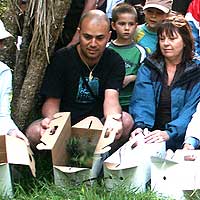Massey biologist to save Darwin's mockingbird muse

Conservation biologist Luis Ortiz-Catedral is going to the Galapagos Islands to help save one of the rarest birds in the world, the critically endangered Floreana mockingbird.
Mr Ortiz-Catedral, whose recently completed PhD thesis fostered the return of endangered kakariki (red-crowned parakeet) to Auckland's offshore islands and mainland, will join the Charles Darwin Foundation, based in the Galapagos. His role is to reintroduce the mockingbird to its home island of Floreana.
Known as "Darwin's muse" because of its pivotal role in the formation of Charles Darwin's Theory of Evolution by natural selection, the mockingbird (Mimus trifasciatus) became extinct on Floreana within several decades of being discovered. Small numbers remain on Floreana's satellite islets of Champion and Gardner-by-Floreana, which are part of the volcanic archipelago scattered around the equator in the Pacific Ocean 970km west of continental Ecuador.
Mr Ortiz-Catedral's fieldwork experience of moving 124 kakariki in separate transfers by helicopter over a three-year period, from Little Barrier Island in the Hauraki Gulf to nearby Motuihe Island and Tawharanui Regional Park, has proved the ideal prerequisite for saving the mockingbird.
"I'm really excited to be following in Darwin's footsteps," he says. "The Galapagos Islands are like Mecca for a biologist. It's one of those places I've always imagined. After 11 years of education as a biologist, its a great honour to be asked to go."
He says New Zealand is widely recognised as a leader in applied conservation, with numerous successful transfers of threatened species thriving on pest-free offshore islands to newly protected island and mainland sanctuaries. As a native of Mexico, his fluency in Spanish was also a must for working with Spanish-speaking Ecuadoreans.
The project will entail similar techniques he used in translocating kakariki, such as studying their habitat, feeding and breeding behaviour as well as taking blood samples to check for diseases before transferring the birds to a new location. Working with local community conservation groups is also an aspect of conservation management he aims to replicate in the Galapagos Islands.
Like in New Zealand, many endemic species in the Galapagos Islands have been devastated by introduced predators such as rats, mice, feral cats, dogs, goats as well as insect parasites. In 1959, the centenary year of the publication of Darwin's The Origin of the Species, the Ecuadorean government declared 97.5 per cent of the archipelago islands a national park. The international Charles Darwin Foundation was founded in the same year to conduct research and provide findings to the government of Ecuador for effective conservation management of the Galapagos Islands. Well-known species in the islands include Galapagos land iguanas, Galapagos Giant tortoise, flightless cormorants, Blue-footed Booby, Waved Albatross and Galapagos Sea Lions.
A parrot enthusiast since he was a youngster, Mr Ortiz-Catedral has been at the Institute of Natural Sciences' Ecology and Conservation group at the Albany campus, led by renowned birdsong researcher Associate Professor Dianne Brunton, since 2002, completing a master's degree and now a PhD.
He had yearned to see New Zealand's native parrots ever since an aunt gave him a wildlife book with an illustration of a kea in front of snow-covered mountain in the South Island. As a boy with pet parrots, the idea of an alpine parrot fascinated him, as did the wildlife of the Galapagos Islands.